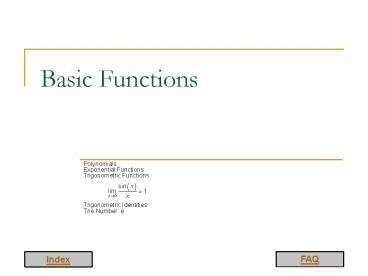Basic Functions - PowerPoint PPT Presentation
1 / 16
Title:
Basic Functions
Description:
A polynomial of degree n has at most n real roots. ... Lemma ... Trigonometric Functions (4) Lemma. Mika Sepp l : Basic Functions. Index. FAQ. Examples ... – PowerPoint PPT presentation
Number of Views:460
Avg rating:3.0/5.0
Title: Basic Functions
1
Basic Functions
- PolynomialsExponential FunctionsTrigonometric
Functions - Trigonometric IdentitiesThe Number e
2
Polynomials
Definition
The polynomial P is of degree n.
A number x for which P(x)0 is called a root
of the polynomial P.
A polynomial of degree n has at most n real
roots. Polynomials may have no real roots, but a
polynomial of an odd degree has always at least
one real root.
Theorem
3
Graphs of Linear Polynomials
Graphs of linear polynomials y ax b are
straight lines. The coefficient a determines
the angle at which the line intersects the x
axis.
Graphs of the linear polynomials 1. y 2x1
(the red line) 2. y -3x2 (the black line) 3. y
-3x 3 (the blue line)
4
Graphs of Higher Degree Polynomials
Problem
The picture on the right shows the graphs and all
roots of a 4th degree polynomial and of a 5th
degree polynomial. Which is which?
Solution
The blue curve must be the graph of the 4th
degree polynomial because of its behavior as x
grows or gets smaller.
5
Measuring of Angles (1)
Angles are formed by two half-lines starting from
a common vertex. One of the half-lines is the
starting side of the angle, the other one is the
ending side. In this picture the starting side
of the angle is blue, and the red line is the
ending side.
Angles are measured by drawing a circle of radius
1 and with center at the vertex of the angle.
The size, in radians, of the angle in question is
the length of the black arc of this circle as
indicated in the picture.
In the above we have assumed that the angle is
oriented in such a way that when walking along
the black arc from the starting side to the
ending side, then the vertex is on our left.
6
Measuring of Angles (2)
The first picture on the right shows a positive
angle.
The angle becomes negative if the orientation
gets reversed. This is illustrated in the second
picture.
This definition implies that angles are always
between -2? and 2?. By allowing angles to rotate
more than once around the vertex, one generalizes
the concept of angles to angles greater than 2?
or smaller than - 2?.
7
Trigonometric Functions (1)
Definition
8
Trigonometric Functions (2)
This basic identity follows directly from the
definition.
Definition
- Graphs of
- sin(x), the red curve, and
- cos(x), the blue curve.
9
Trigonometric Functions (3)
The size of an angle is measured as the length a
of the arc, indicated in the picture, on a circle
of radius 1 with center at the vertex.
On the other hand, sin(a) is the length of the
red line segment in the picture.
Lemma
The above inequality is obvious by the above
picture. For negative angles a the inequality is
reversed.
10
Trigonometric Functions (4)
Lemma
11
Examples
Problem 1
Solution
12
Examples
Problem 2
Solution
13
Trigonometric Identities 1
Defining Identities
Derived Identities
14
Trigonometric Identities 2
Derived Identities (contd)
15
Exponential Functions
16
The Number e
Definition
The slope of a tangent line is the tangent of the
angle at which the tangent line intersects the
x-axis.
e?2.718281828































